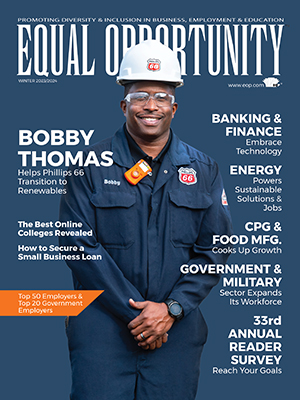| |

Equal Opportunity Magazine, launched in 1968, is a career-guidance and recruitment magazine offered at no charge to qualified African American, Hispanic, Native-American, and Asian-American college students and professionals in career disciplines. Equal Opportunity empowers readers to move ahead in their job search and/or current workplace environment.
This magazine reaches students and professionals nationwide at their home addresses, colleges and universities, and chapters of student and professional organizations.
If you are a student or professional who is a member of a minority group, Equal Opportunity is available to you FREE!

|
|
 Equal Opportunity
Equal Opportunity
» Featured Articles
» Subscription Information
» Reader Survey
» Companies Actively Recruiting

RIT/NTID ESTABLISHES MASTER’S DEGREE PROGRAM IN HEALTHCARE INTERPRETATION
Rochester Institute of Technology’s National Technical Institute for the Deaf received approval from New York State Department of Education to establish a first-of-itskind master of science degree program in healthcare interpretation to meet the demands of nationally certified sign-language interpreters desiring a master’s degree specific to working in healthcare environments.
The program is a collaborative venture between NTID and RIT’s College of Health Sciences and Technology and marks the first time that NTID will be partnering with another RIT college to provide a master’s degree program.
The program will meet the growing demand for specialized sign-language healthcare interpreters as more deaf and hard-of-hearing people enter the medical/healthcare fields, increase the number of specialized sign-language interpreters working in patient healthcare settings, and prepare interpreters to work in administrative roles to ensure language access to patients in hospital settings.
According to projections from the U.S. Bureau of Labor Statistics, between 2012 and 2022, there will be a 46 percent employment growth for interpreters and translators, much faster than the average for all occupations. The field is on track to add more than 29,000 new positions during that time period. Graduates of the program may find work as staff interpreters, freelance interpreters, or on a per-diem basis in healthcare, healthcare education, and healthcare research settings .
Applicants must have certification from the National Registry of Interpreters for the Deaf and hold a bachelor’s degree from a regionally accredited college or university for admission.
The program begins with a one-week on-campus residency professional seminar, with the remainder of the program delivered online.
 » Feedback for the Editor
» Feedback for the Editor
» Request Article Copy
|
|